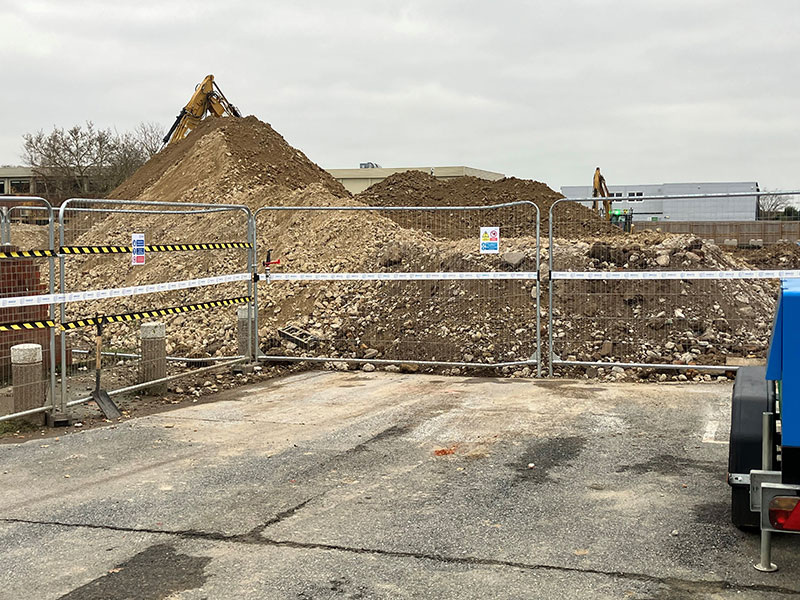What is CL:AIRE in relation to asbestos-contaminated land?
If you suspect that asbestos is present in land or soil for which you are responsible, it is crucial that you take careful and well-informed decisions in order to minimise risk.
In this regard, a protocol known as Contaminated Land: Applications in Real Environments, or CL:AIRE, may be of relevance to your decision-making.
But what exactly is CL:AIRE, and what is its applicability to situations involving asbestos-contaminated land?
What is CL:AIRE, and what does it do?
CL:AIRE is the name of a UK charity that provides training resources and information for all those involved in sustainable land use.
The term CL:AIRE, however, is also used in reference to a Code of Practice (CoP) – or to give its full name, the Definition of Waste: Development Industry Code of Practice. This CoP can provide an important framework allowing for the reuse of excavated materials on-site, or the transfer of such materials between sites, without them being categorised as waste.
The CL:AIRE CoP is voluntary, and applies only to England and Wales. It is also possible for conclusions on whether a given material is waste to be made without reference to the CoP. However, the use of this Code of Practice could serve as an alternative to the use of Environmental Permits or exemptions.
There are various situations in which use of the CoP could be useful. These include when those responsible for dealing with soil or land are looking to directly transfer clean, uncontaminated soil from one development site to another, as well as scenarios involving the reuse of both contaminated and noncontaminated excavated materials on their site of origin.
Another scenario that the CoP would support, would be a network of sites being established within a Hub and Cluster arrangement, between which both contaminated and noncontaminated material could be transferred. Or the prospective user of the CoP may be interested in operating fixed soil treatment facilities for the production of a non-waste product.
In theory, use of the CL:AIRE CoP could help bring a range of advantages. These include encouraging the development of brownfield sites, and helping to reduce both waste to landfill and the import of quarried material. The CL:AIRE CoP can also help reduce transport distances for materials off site.
Furthermore, using the CL:AIRE CoP incurs lower costs than the task of applying for an Environmental Permit, and is faster as well.
However, in order for the CL:AIRE CoP to be applied, the production of a Materials Management Plan, or MMP, is crucial. The MMP will need to provide supporting evidence to demonstrate that:
- Use of the given material will not present a risk to human health or the environment;
- The material is suitable for use;
- There is certainty of use;
- The amount of material used will be no greater than is actually needed and permitted by planning.
As anyone who knows about the nature and risks of asbestos will be able to appreciate, asbestos-contaminated soil presents particular challenges when it comes to fulfilling the above requirements.
It can be difficult to even identify whether asbestos is present in soil or land, given that while this material in the ground can take the form of asbestos-containing products that are relatively intact, it can also consist of individual fibres that one cannot easily spot with the naked eye.
Any disturbance to such asbestos materials – as might occur due to construction or other works – can cause the release of asbestos fibres into the air.
This can present the risk of someone nearby breathing in or ingesting the asbestos fibres. That, in turn, could potentially heighten their long-term risk of developing asbestos-related diseases such as mesothelioma, asbestosis, or asbestos-related lung cancer.
Such conditions may only become apparent in the sufferer at a relatively late stage of the disease’s development, and can frequently be fatal.
What are the best practices for managing asbestos-contaminated land?
The CL:AIRE Code of Practice sets out good practice for those in the development industry to use when they are:
- Assessing on a site-specific basis whether excavated materials are classified as waste; and
- Determining on a site-specific basis when treated excavated waste can cease to be waste for a particular use.
The CoP sets out an auditable system to demonstrate whether compliance with the CoP has been achieved.
It is the responsibility of a holder of material to conclude whether the given material is waste. The CoP provides scope for the holder of the material to arrive at their own view, and to demonstrate how they did so in relation to current law.
Use of the CoP, then, necessitates a degree of self-regulation and a high level of professional integrity on the part of those involved.
When the Environment Agency (EA) is making its own decision on whether to regulate the given materials as waste, it will consider this CoP. If those involved have dealt with the materials in a way that complies with the CoP, the EA considers that such materials are unlikely to be waste, provided that they are used for land development purposes.
This could be the case due to the materials not having been discarded in the first place, or because the materials have been submitted to a recovery operation and have been completely recovered, thereby ceasing to be waste.
There are three broad steps of “good practice” when it comes to dealing with materials – such as asbestos-contaminated land – in accordance with CL:AIRE. Those are:
- Making sure an adequate Materials Management Plan (MMP) has been implemented, covering the use of materials on a specific site;
- Ensuring the MMP is based on a suitable risk assessment, underpinning the Remediation Strategy or Design Statement, and concluding that the objectives of preventing human health from being harmed, and the environment from being polluted, will be satisfied as long as the materials are used in the proposed manner; and
- Making sure the materials are actually treated and used as outlined in the MMP, with a Verification Report subsequently demonstrating this.
In order to confirm that the first two of the above steps have been carried out, it will be necessary for a Qualified Person to review the relevant documents and provide a declaration to the EA before use of the given materials.
When the EA receives such a Declaration, demonstrating that the materials are to be dealt with in compliance with the MMP, it will take the view that the materials are not waste.
In the event, however, of the materials not being used in accordance with the MMP or risk assessment, or it being discovered that the materials are likely to cause harm to human health or the environment, the EA may conclude that the materials have been discarded and are waste.
This is why it is so important, at the conclusion of works, for a Verification Report to be prepared, proving that the materials have been treated and used in an acceptable manner. This report should be provided to the EA if requested.
Presuming that the Code’s requirements are complied with, the given materials will not be waste. If, though, the particular material is waste, it will be necessary for those dealing with the material to obtain an Environmental Permit, in order to lawfully deposit or reuse it.
Such a requirement would apply unless the material is “uncontaminated soil and other naturally occurring material excavated in the course of construction activities where it is certain that the material will be used for the purposes of construction in its natural state on the site from which it was excavated”.
Seek a quote from Oracle Solutions for any of a range of asbestos services
Hopefully, the above will have helped give you greater certainty with regard to the potential applicability of the CL:AIRE Code of Practice to asbestos-contaminated land. You should also now feel more informed with regard to the steps that will be required – including risk assessment and management planning – if you are to achieve compliance.
Are you unsure about any aspect of managing possible or confirmed asbestos contamination in land or soil for which you are responsible? If so, here at Oracle Solutions, we can provide the highest standard of specialised and responsive advice, guidance, and related asbestos services.
Contact the Oracle Solutions team by phone or email today, and we will be pleased to provide you with a fast, free, and competitive quote.

Written by Brendan Coleman
Brendan Coleman, with decades of experience in the asbestos industry, is a dedicated Quality Manager. Certified as a surveyor and analyst, he is adept in operations and quality management with a keen focus on HSE compliance. His expertise is pivotal in maintaining high safety and efficiency standards. Brendan ensures our UKAS accreditation requirements are consistently met and exceeded, upholding stringent standards in asbestos remediation. His commitment to enhancing quality and customer satisfaction makes him an essential advisor in asbestos management.

